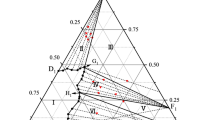Abstract
Nonaqueous phase liquid (NAPL) contaminants that are chemical mixtures often contain compounds that are solids in their pure states. In the environment, weathering processes cause shifts in multicomponent NAPL composition, thereby enriching the NAPL in the less soluble compounds which may result in their eventual solidification. In this paper, we review the thermodynamic theory governing solid–liquid phase equilibria for the multicomponent NAPLs, and we present experimental observations of such phase equilibria for binary, ternary, and quaternary mixtures of polycyclic aromatic hydrocarbons (PAHs). If the NAPL phase behaves as an ideal solution and if the solid precipitate is pure, then a compound's mole fraction solubility limit in the NAPL phase equals its solid–liquid reference fugacity ratio. This value is a constant at the temperature of the system. If the NAPL phase is a non‐ideal solvent or if the solid is a solid solution, prediction of NAPL solidification in the environment is considerably more difficult. Experimental results indicate that for compounds such as naphthalene and acenaphthene, the solid–liquid reference fugacity ratio serves as a good indicator of the solubility limits in the NAPL phase. For phenanthrene, the solids that form when this compound exceeds its solubility limit are solid solutions that consistently include large portions of 2‐methylnaphthalene. These results suggest that the independent behavior implied by ideal solubility theory may not be an accurate descriptor of NAPL solidification phenomena for all PAH‐containing NAPLs.
Similar content being viewed by others
References
Banerjee, S.: 1984, Solubility of organic mixtures in water, Environ. Sci. Tech. 18, 587–591.
Burris, D. R., and MacIntyre, W. G.: 1985,Water solubility behavior of binary hydrocarbon mixtures, Environ. Toxic. Chem. 4, 371–377.
Daubert, T. E. and Danner, R. P.: 1989, Physical and Thermodynamic Properties of Pure Chemicals: Data Compilation, Hemisphere Publishing Co., New York.
Garg, S., Nie, Y., Rixey, W. G..: 1998, Dissolution of aromatic hydrocarbons from residually trapped hydrocarbon mixtures, In: C. V. Chrysikopoulos, T. C. Harmon and J. Bear (eds) Proc. 1998 Symp. on Environ. Models and Experiments Envisioning Tomorrow, EnviroMEET'98, Behavior and Remediation of Nonaqueous Phase Contaminants in the Subsurface Irvine, CA, pp. 91–100.
Hildebrand, J. H. and Scott, R. L.: 1950, The Solubility of Nonelectrolyte, 3rd edn, Reinhold Publishing Co. New York, NY, Ch. 17.
Knightes, C. D., Peters, C. A.: 1996, Numerical simulation of multicomponent NAPL dissolution and precipitation, WEFTEC' 96, Proc. Water Environment Federation, 69th Annual Conference, Dallas, TX., Vol. I, Part I: Wastewater Treatment Research, pp. 333–343.
Lane, W. F. and Loehr, R. C.: 1992, Estimating the equilibrium aqueous concentrations of polynuclear aromatic hydrocarbons in complex mixtures, Environ. Sci. Tech. 26, 983–990.
Lee, L. S., Hagwall, M., Delfino, J. J. and Rao, P. S. C.: 1992, partitioning of polycyclic aromatic hydrocarbons from diesel fuel into water, Environ. Sci. Tech. 26, 2104–2110.
Luthy, R. G., Dzombak, D. A., Peters, C. A., Roy, S. B., Ramaswami, A., Nakles, D. V. and Nott, B. R.: 1994, Remediating tar-contaminated soils at manufactured gas plant sites: technological challenges, Environ. Sci. Tech. 28, 266A–276A.
Mackay, D., Shiu, W. Y., Maijanen, A., and Feenstra, S.: 1991, Dissolution of Nonaqueous phase liquids in groundwater, J. Contaminant Hydrology 8, 23–42.
Mukherji, S., Peters, C. A., and Weber, W. J. Jr.: 1997, Mass Transfer of Polynuclear Aromatic Hydrocarbons from Complex DNAPL Mixtures, Environ. Sci. Tech. 31, 416–423.
Peters, C. A. and Luthy, R. G.: 1993, Coal tar dissolution in water-miscible solvents: experimental evaluation, Environ. Sci. Tech. 27, 2831–2843.
Peters, C. A., Mukherji, S., Knightes, C. D. and Weber, W. J. Jr.: 1997, Phase stability of multicomponent NAPLs containing PAHs, Environ. Sci. Tech. 31, 2540–2546.
Peters, C. A., Blackburn, E. D., and Celia, M. A.: 1998, Spatial and temporal variation of composition in multicomponent NAPLs, In: V. N. Burganos, G. P. Karatza, A. C. Payatakes, C. A. Brebbia, W. G. Gray and G. F. Pinder (eds), Proc. XII Int. Conf. Comput. Meth. Water Resour. Comput. Mech. Publ..
Peters, C. A., Mukherji, S., Weber, W. J. Jr.: 1999, UNIFAC modeling of multicomponent NAPs containing polycyclic aromatic hydrocarbons, Environ. Toxicology and Chem. 18(3).
Prausnitz, J. M., Lichtenthaler, R. N., de Azevedo, E. G.: 1986, Molecular Thermodynamics of Fluid Phase Equilibria, 2nd edn, Prentice-Hall: Englewood Cliffs, New Jersey, Ch. 9.
Rhines, F. N.: 1956, Phase Diagrams in Metallurgy, Their Development and Application, McGraw Hill: New York, Ch. 14.
Rudolfi, E.: 1909, Zeitschrift f¨ur physikalische Chemie, 66, 705–732.
US EPA: 1993, Provisional Guidance for Quantitative Risk Assessment of Polycyclic Aromatic Hydrocarbons, Office of Research and Development, United States Environmental Protection Agency, Washington, DC. EPA/600/R-93/089.
Author information
Authors and Affiliations
Rights and permissions
About this article
Cite this article
Peters, C.A., Wammer, K.H. & Knightes, C.D. Multicomponent NAPL Solidification Thermodynamics. Transport in Porous Media 38, 57–77 (2000). https://doi.org/10.1023/A:1006615301396
Issue Date:
DOI: https://doi.org/10.1023/A:1006615301396



